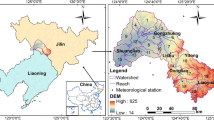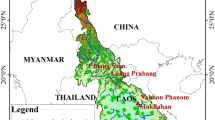Abstract
The assessment of spatial and temporal variation of water quality influenced by land use is necessary to manage the environment sustainably in basin scales. Understanding the correlations between land use and different formats of nonpoint source nutrients pollutants is a priority in order to assess pollutants loading and predicting the impact on surface water quality. Forest, upland, paddy field, and pasture are the dominant land use in the study area, and their land use pattern status has direct connection with nonpoint source (NPS) pollutant loading. In this study, two land use scenarios (1995 and 2010) were used to evaluate the impact of land use changes on NPS pollutants loading in basins upstream of Three Gorges Reservoir (TGR), using a calibrated and validated version of the soil and water assessment tool (SWAT) model. The Pengxi River is one of the largest tributaries of the Yangtze River upstream of the TGR, and the study area included the basins of the Dong and Puli Rivers, two major tributaries of the Pengxi River. The results indicated that the calibrated SWAT model could successfully reproduce the loading of NPS pollutants in the basins of the Dong and Puli Rivers. During the 16-year study period, the land use changed markedly with obvious increase of water body and construction. Average distance was used to measure relative distribution patterns of land use types to basin outlets. Forest was mainly distributed in upstream areas whereas other land use types, in particular, water bodies and construction areas were mainly distributed in downstream areas. The precipitation showed a non-significant influence on NPS pollutants loading; to the contrary, interaction between precipitation and land use were significant sources of variation. The different types of land use change were sensitive to NPS pollutants as well as land use pattern. The influence of background value of soil nutrient on NPS pollutants loading was evaluated in upland and paddy field. It was found that total nitrogen (TN) and total phosphorous (TP) in upland were more sensitive to NPS pollutants loading than in paddy fields. The results of this study have implications for management of the TGR to reduce the loading of NPS pollutants into downstream water bodies.







Similar content being viewed by others
References
Ahearn DS, Sheibley RW, Dahlgren RA et al (2005) Land use and land cover influence on water quality in the last free-flowing river draining the western Sierra Nevada, California. J Hydrol 313(3):234–247
Arnold JG, Srinivasan R, Muttiah RS, Williams JR (1998) Large area hydrologic modeling and assessment. I. Model development. J Am Water Res Assoc 34(1), 1
Balmford A, Bruner A, Cooper P et al (2002) Economic reasons for conserving wild nature. Science 297(5583):950–953
Chai C, Yu Z, Shen Z et al (2009) Nutrient characteristics in the Yangtze River Estuary and the adjacent East China Sea before and after impoundment of the Three Gorges Dam. Sci Total Environ 407(16):4687–4695
Chang H (2008) Spatial analysis of water quality trends in the Han River basin, South Korea. Water Res 42(13):3285–3304
Chaplot V, Saleh A, Jaynes DB et al (2004) Predicting water, sediment and NO3-N loads under scenarios of land-use and management practices in a flat watershed. Water Air Soil Pollut 154(1–4):271–293
Chung SO, Kim HS, Kim JS (2003) Model development for nutrient loading from paddy rice fields. Agric Water Manag 62(1):1–17
Downing JA, McClain M, Twilley R et al (1999) The impact of accelerating land-use change on the N-cycle of tropical aquatic ecosystems: current conditions and projected changes. Biogeochemistry 46(1–3):109–148
Fan F, Xie D, Wei C, Ni J, Yang J, Tang Z, Zhou C (2015) Reducing soil erosion and nutrient loss on sloping land under crop-mulberry management system. Environ Sci Pollut Res 22(18)14067–14077
Feichtinger F, Smidt S, Klaghofer E (2002) Water and nitrate fluxes at a forest site in the North Tyrolean Limestone Alps. Environ Sci Pollut Res 9(2):31–36
Ferrier RC, Whitehead PG, Sefton C et al (1995) Modelling impacts of land use change and climate change on nitrate-nitrogen in the River Don, North East Scotland. Water Res 29(8):1950–1956
Geza M, McCray JE (2008) Effects of soil data resolution on SWAT model stream flow and water quality predictions. J Environ Manag 88(3):393–406
Guo LB, Gifford RM (2002) Soil carbon stocks and land use change: a meta analysis. Glob Chang Biol 8(4):345–360
Ileva NY, Shibata H, Satoh F et al (2009) Relationship between the riverine nitrate–nitrogen concentration and the land use in the Teshio River watershed, North Japan. Sustain Sci 4(2):189–198
Katsuyama M, Shibata H, Yoshioka T et al (2009) Applications of a hydro-biogeochemical model and long-term simulations of the effects of logging in forested watersheds. Sustain Sci 4(2):179–188
Kim HJ, Sudduth KA, Hummel JW (2009) Soil macronutrient sensing for precision agriculture. J Environ Monit 11(10):1810–1824
Lee MD, Bastemeijer TF (1991) Drinking water source protection; a review of environmental factors affecting community water supplies. In IRC occasional paper (No. 15). IRC
Lee SW, Hwang SJ, Lee SB et al (2009) Landscape ecological approach to the relationships of land use patterns in watersheds to water quality characteristics. Landsc Urban Plan 92(2):80–89
Lenat DR, Crawford JK (1994) Effects of land use on water quality and aquatic biota of three North Carolina Piedmont streams. Hydrobiologia 294(3):185–199
Leone A, Ripa MN, Uricchio V et al (2009) Vulnerability and risk evaluation of agricultural nitrogen pollution for Hungary’s main aquifer using DRASTIC and GLEAMS models. J Environ Manag 90(10):2969–2978
Lin YP, Hong NM, Wu PJ et al (2007) Impacts of land use change scenarios on hydrology and land use patterns in the Wu-Tu watershed in Northern Taiwan. Landsc Urban Plan 80(1):111–126
Liu YM, Jia SF, Jiang LW et al (2003) A study on the impact of the Three Gorges Reservoir on potential eutrophication in backwaters of tributaries of Chongqing section of Yangtze River. Geogr Res 22(1):67–72
McElroy AD (1976) Loading functions for assessment of water pollution from nonpoint sources (Vol. 1). US Environmental Protection Agency, Office of Research and Development, [Office of Air, Land, and Water Use]
Metzger MJ, Rounsevell MDA, Acosta-Michlik L et al (2006) The vulnerability of ecosystem services to land use change. Agric Ecosyst Environ 114(1):69–85
Metzger MJ, Schröter D, Leemans R et al (2008) A spatially explicit and quantitative vulnerability assessment of ecosystem service change in Europe. Reg Environ Chang 8(3):91–107
Molina-Navarro E, Trolle D, Martínez-Pérez S et al (2014) Hydrological and water quality impact assessment of a Mediterranean limno-reservoir under climate change and land use management scenarios. J Hydrol 509:354–366
Munodawafa A (2007) Assessing nutrient losses with soil erosion under different tillage systems and their implications on water quality. Physics and Chemistry of the Earth, Parts A/B/C 32(15):1135–1140
Nash JE, Sutcliffe JV (1970) River flow forecasting through conceptual models part I—a discussion of principles. J Hydrol 10(3):282–290
Neitsch SL, Arnold JG, Kiniry JR, Williams JR (2011) Soil and water assessment tool theoretical documentation version 2009. Texas Water Resources Institute
Ngoye E, Machiwa JF (2004) The influence of land-use patterns in the Ruvu river watershed on water quality in the river system. Physics and Chemistry of the Earth, Parts A/B/C 29(15):1161–1166
Niraula R, Kalin L, Srivastava P et al (2013) Identifying critical source areas of nonpoint source pollution with SWAT and GWLF. Ecol Model 268:123–133
Omernik J M. The influence of land use on stream nutrient levels. US Environmental Protection Agency, Office of Research and Development, Corvallis Environmental Research Laboratory, Eutrophication Survey Branch, 1976.
Ouyang W, Huang H, Hao F et al (2012) Evaluating spatial interaction of soil property with non-point source pollution at watershed scale: the phosphorus indicator in Northeast China. Sci Total Environ 432:412–421
Panagopoulos Y, Makropoulos C, Baltas E et al (2011) SWAT parameterization for the identification of critical diffuse pollution source areas under data limitations. Ecol Model 222(19):3500–3512
Ren L, Cui E, Sun H (2014) Temporal and spatial variations in the relationship between urbanization and water quality. Environ Sci Pollut Res 21(23):13646–13655
Ribarova I, Ninov P, Cooper D (2008) Modeling nutrient pollution during a first flood event using HSPF software: Iskar River case study, Bulgaria. Ecol Model 211(1):241–246
Sharpley AN, Kleinman PJA, Heathwaite AL et al (2008) Phosphorus loss from an agricultural watershed as a function of storm size. J Environ Qual 37(2):362–368
Solheim AL, Austnes K, Eriksen TE et al (2010) Climate change impacts on water quality and biodiversity: Background Report for EEA European Environment State and Outlook Report 2010. Czech Republic, Prague
Tang J, Wang T, Zhu B, Zhao P, Xiao Y, Wang R (2015) Tempo-spatial analysis of water quality in tributary bays of the Three Gorges Reservoir region (China). Environ Sci Pollut Res 22(21):16709–16720
Tong STY, Chen W (2002) Modeling the relationship between land use and surface water quality. J Environ Manag 66(4):377–393
Trisurat Y, Alkemade R, Verburg PH (2010) Projecting land-use change and its consequences for biodiversity in Northern Thailand. Environ Manag 45(3):626–639
Vogel HJ, Weller U, Ippisch O (2010) Non-equilibrium in soil hydraulic modelling. J Hydrol 393(1):20–28
Wang G, Xu Z, Zhang S (2014) The influence of land use patterns on water quality at multiple spatial scales in a river system. Hydrol Process 28(20):5259–5272
Williams J R, Hann R W J. Optimal operation of large agricultural watersheds with water quality constraints. Available from the National Technical Information Service, Springfield VA 22161 as PB-288 942, Price codes: A 08 in paper copy, A 01 in microfiche. Technical Report, 1978 (96).
Ye X, Zhang Q, Viney NR (2011) The effect of soil data resolution on hydrological processes modelling in a large humid watershed. Hydrol Process 25(1):130–140
Zhang J, Zhengjun L, Xiaoxia S (2009a) Changing landscape in the Three Gorges Reservoir Area of Yangtze River from 1977 to 2005: land use/land cover, vegetation cover changes estimated using multi-source satellite data. Int J Appl Earth Obs Geoinf 11(6):403–412
Zhang XS, Srinivasan R, Bosch D (2009b) Calibration and uncertainty analysis of the SWAT model using genetic algorithms and Bayesian model averaging. J Hydrol 374(3–4):307–317
Acknowledgments
This research is supported by the National Program on Key Basic Research Project of China (Grant No. 2013BAB05B04), the Beijing Higher Education Young Elite Teacher Project (Grant No. YETP0275), and the Fundamental Research Funds for the Central Universities (Grant No. 2012LZD10).
Author information
Authors and Affiliations
Corresponding author
Additional information
Responsible editor: Philippe Garrigues
Rights and permissions
About this article
Cite this article
Yang, H., Wang, G., Wang, L. et al. Impact of land use changes on water quality in headwaters of the Three Gorges Reservoir. Environ Sci Pollut Res 23, 11448–11460 (2016). https://doi.org/10.1007/s11356-015-5922-4
Received:
Accepted:
Published:
Issue Date:
DOI: https://doi.org/10.1007/s11356-015-5922-4




